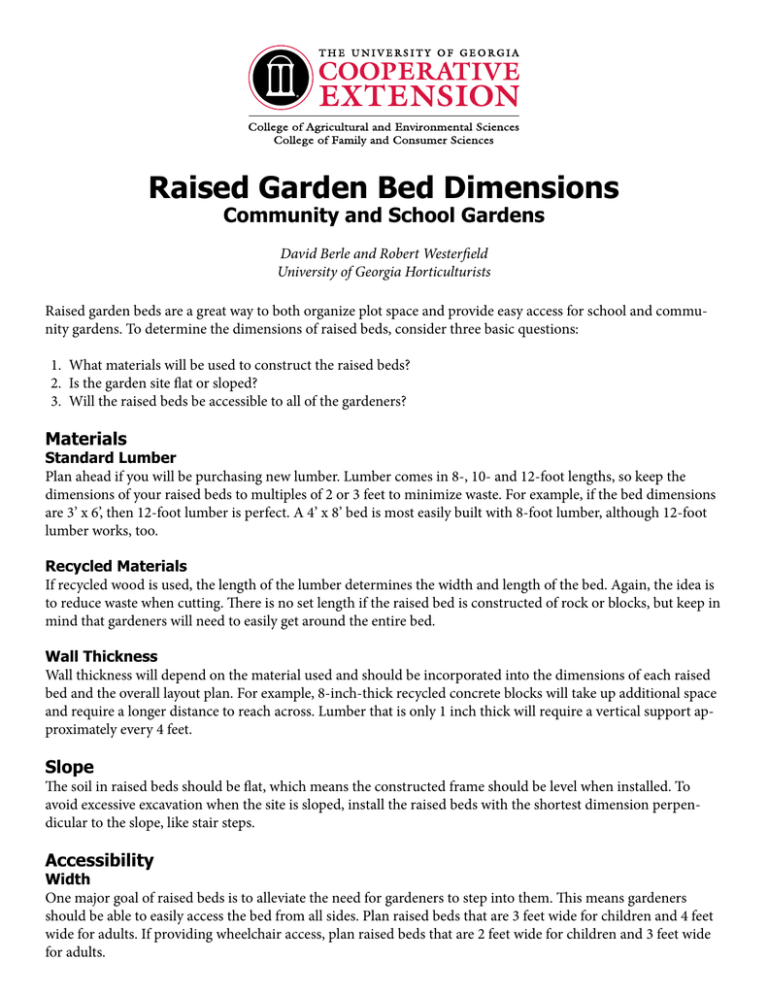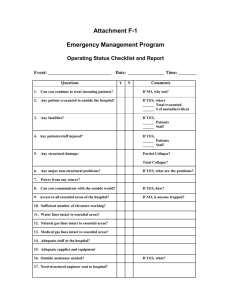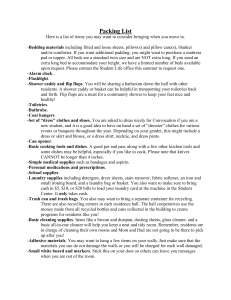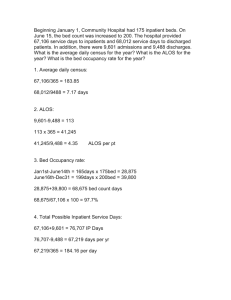Raised Garden Bed Dimensions Community and School Gardens
advertisement

Raised Garden Bed Dimensions Community and School Gardens David Berle and Robert Westerfield University of Georgia Horticulturists Raised garden beds are a great way to both organize plot space and provide easy access for school and community gardens. To determine the dimensions of raised beds, consider three basic questions: 1. What materials will be used to construct the raised beds? 2. Is the garden site flat or sloped? 3. Will the raised beds be accessible to all of the gardeners? Materials Standard Lumber Plan ahead if you will be purchasing new lumber. Lumber comes in 8-, 10- and 12-foot lengths, so keep the dimensions of your raised beds to multiples of 2 or 3 feet to minimize waste. For example, if the bed dimensions are 3’ x 6’, then 12-foot lumber is perfect. A 4’ x 8’ bed is most easily built with 8-foot lumber, although 12-foot lumber works, too. Recycled Materials If recycled wood is used, the length of the lumber determines the width and length of the bed. Again, the idea is to reduce waste when cutting. There is no set length if the raised bed is constructed of rock or blocks, but keep in mind that gardeners will need to easily get around the entire bed. Wall Thickness Wall thickness will depend on the material used and should be incorporated into the dimensions of each raised bed and the overall layout plan. For example, 8-inch-thick recycled concrete blocks will take up additional space and require a longer distance to reach across. Lumber that is only 1 inch thick will require a vertical support approximately every 4 feet. Slope The soil in raised beds should be flat, which means the constructed frame should be level when installed. To avoid excessive excavation when the site is sloped, install the raised beds with the shortest dimension perpendicular to the slope, like stair steps. Accessibility Width One major goal of raised beds is to alleviate the need for gardeners to step into them. This means gardeners should be able to easily access the bed from all sides. Plan raised beds that are 3 feet wide for children and 4 feet wide for adults. If providing wheelchair access, plan raised beds that are 2 feet wide for children and 3 feet wide for adults. Length The length of a bed is not as critical as the width, but bear in mind that very long raised beds can be a hassle to walk and work around. While the length of a raised bed will be partly determined by available materials, keep in mind that the cost of lumber increases noticeably if the length is more than 12 feet. Height The higher the bed, the more imported soil will be required. This will add to the cost and labor involved in the garden project. In some situations, raised planters can be built that are 10 inches deep, but elevated off the ground with legs or blocks. This is ideal for wheelchair access and also saves on imported soil. However, the bottom must be strong enough to both hold the weight of the soil when it is wet and still allow water to drain. A few other considerations to keep in mind: • Most garden crops need at least 10 inches of soil to thrive. If the raised bed height is lower than this, till the existing soil below the raised bed. • If the raised bed is on top of a hard surface, the minimum recommended height of 10 inches may not be deep enough for some crops, like potatoes. • Young children need beds closer to the ground. • For wheelchair access, beds should be 24 inches tall. • A bed that is 36 inches off the ground helps avoid excessive bending over. • Consider having a mix of bed heights to accommodate different gardeners. Paths If possible, beds should be laid out in a pattern that allows access to one central path that stretches from one end of the garden to the other. A wider central path provides room for gathering and access for everyone. If it is a very large garden, more than one such path will prove useful. To provide access for a small truck, make this path at least 10 feet wide. Gardeners also need paths to move from bed to bed on foot and sometimes in a wheelchair. At an absolute minimum, 12-inch paths will be needed between raised beds. This width works if the space is tight and there won’t be a lot of gardeners working at the same time, but to allow more comfortable access, 18- to 24-inch paths are ideal. For paths to provide enough room for carts, wheelbarrows and wheelchairs, allow 4 feet between beds. Orientation Orientation of raised beds is not usually a problem if adequate space is left between beds for access. Tall crops will shade lower crops behind them if both are planted in the same bed. Tall crops will shade lower crops in nearby beds if they are planted on an east-west orientation and if the beds are close together. If possible, lay out beds in a north-south direction. Irrigation Consider the irrigation system when you are planning the layout of raised beds. Drip irrigation is much easier to install when beds are in an orderly pattern, preferably a straight line. Overhead sprinklers can be placed and adjusted to cover almost any garden layout, but they work best if raised beds are in a circular, square or rectangular pattern. Hand watering will require dragging a hose throughout the garden; uniform bed spacing and layout will make this task easier. February 2013 Circular 1027-4 The University of Georgia and Ft. Valley State University, the U.S. Department of Agriculture and counties of the state cooperating. Cooperative Extension, the University of Georgia College of Agricultural and Environmental Sciences, offers educational programs, assistance and materials to all people without regard to race, color, national origin, age, gender or disability. The University of Georgia is committed to principles of equal opportunity and affirmative action.





